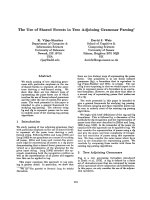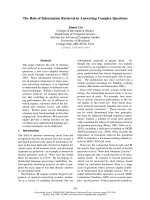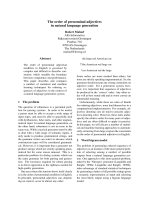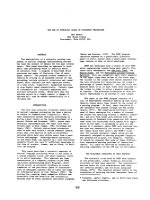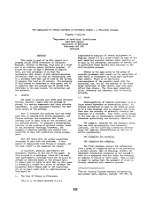báo cáo khoa học: "The analysis of quantitative variation in natural populations with isofemale strains" pptx
Bạn đang xem bản rút gọn của tài liệu. Xem và tải ngay bản đầy đủ của tài liệu tại đây (576.31 KB, 12 trang )
The
analysis
of
quantitative
variation
in
natural
populations
with
isofemale
strains
A.A.
HOFFMANN
P.A.
PARSONS
Department
of
Genetics
and
Human
Variation,
La
Trobe
University,
Bundoora
3083,
Victoria,
Australia
Summary
Isofemale
strains
are
having
an
increasing
role
in
the
analysis
of
variability
of
ecological
and
behavioural
traits
in
natural
populations.
This
paper
therefore
considers
the
association
between
heritability
and
phenotypic
variation
within
and
between
isofemale
strains.
Heritability
from
an
isofemale
strain
analysis
approximates
narrow
heritability
over
a
wide
range
of
dominance
values,
particularly
when
genes
contributing
to
variation
in
a
trait
are
at
intermediate
frequencies.
Meaningful
heritability
estimates
require
that
isofemale
strains
are
maintained
at
a
population
size
greater
than
50
and
tested
within
5
generations
after
establishment.
Values
of
heritabilities
for
morphological
traits
in
Drosophila
melanogaster
were
similar
to
those
estimated
from
a
conventio-
nal
sib
analysis.
Published
data
on
isofemale
strains
can
therefore
be
put
into
a
theoretical
framework.
The
contribution
of
isofemale
strain
analyses
to
the
debate
about
the
number
of
loci
affecting
variation
in
quantitative
traits
is
briefly
discussed.
Keys
words :
isofemale
strain,
heritability,
Drosophila
melanogaster,
gene
number,
morphologi-
cal
trait.
Résumé
Analyse
de
la
variabilité
quantitative
dans
des
populations
naturelles
par
des
lignées
isofemelles
Les
lignées
isofemelles
jouent
un
rôle
croissant
dans
l’analyse
de
la
variabilité
des
caractères
écologiques
et
comportementaux
dans
les
populations
naturelles.
Cet
article
a
trait
aux
relations
existant
entre
l’héritabilité
et
la
variation
phénotypique
intra
et
entre
lignées
isofemelles.
L’hérita-
bilité
obtenue
par
analyse
de
lignées
isofemelles
constitue
une
approximation
de
l’héritabilité
au
sens
étroit
pour
une
large
gamme
de
valeurs
de
dominance,
en
particulier
lorsque
les
gènes
contribuant
à
la
variabilité
du
caractère
ont
des
fréquences
intermédiaires.
Une
estimation
pertinente
de
l’héritabilité
nécessite
que
les
lignées
isofemelles
soient
maintenues
à
un
effectif
de
population
supérieur
à
50
et
analysées
au
cours
des
cinq
générations
suivant
leur
fondation.
Les
valeurs
d’héritabilité
qui
ont
été
obtenues
pour
des
caractères
morphologiques
chez
Drosophila
melanogaster
étaient
similaires
à
celles
estimées
par
l’analyse
conventionnelle
de
germains.
Les
données
publiées
sur
des
lignées
isofemelles
peuvent
donc
être
introduites
dans
un
cadre
théori-
que.
La
contribution
des
analyses
de
lignées
isofemelles
au
débat
sur
le
nombre
de
locus
affectant
la
variabilité
de
caractères
quantitatifs
est
brièvement
discutée.
Mots
clés :
lignée
isofemelle,
héritabilité,
Drosophila
melanogaster,
nombre
de
gènes,
caractère
morphologique.
I.
Introduction
Isofemale
strains
have
an
important
role
in
the
assessment
of
the
nature
and
range
of
phenotypic
variation
in
natural
populations.
While
these
strains
were
initially
used
to
study
quantitative
variation
in
morphological
traits,
they
are
of
particular
value
for
traits
involved
in
determining
the
distribution
and
abundance
of
organisms
(PARSONS,
1983).
A
major
advantage
of
isofemale
strains
is
that
genetic
information
is
obtainable
in
species
where
details
of
the
genome
are
not
well
known.
This
enables
comparative
assessments
of
the
evolutionary
significance
of
polygenic
variation
in
species
where
the
underlying
genes
cannot
be
readily
located
due
to
inadequate
linkage
maps
(PARSONS,
1980a).
From
an
analysis
of
variance
within
and
between
isofemale
strains,
estimates
of
the
relative
proportions
of
genetic
and
environmental
variances
in
populations
can
be
obtained.
Such
analyses
have
been
useful
in
comparative
studies
of
populations
from
different
habitats
(PARSONS,
1980b)
and
in
comparing
different
traits
(R
OCKWELL
et
al.,
1975).
However,
it
is
important
to
relate
these
estimates
to
the
heritability
of
the
quantitative
characters.
The
major
aim
of
this
paper
is
to
examine
how
variation
among
isofemale
strains
may
be
used
to
estimate
heritability.
It
will
be
shown
that
a
standard
procedure
of
analysing
isofemale
strain
variation
within
a
few
generations
of
laboratory
culture
can
lead
to
useful
information
about
narrow
heritability,
providing
that
the
effective
population
size
of
each
strain
is
kept
fairly
large.
Experimental
data
for
morphological
traits
in
Drosophila
melanogaster
will
be
used
to
compare
heritability
estimates
from
isofemale
strains
with
those
obtained
with
a
sib
analysis.
A
subsidiary
aim
is
to
consider
the contribution
that
isofemale
strain
analysis
can
make
to
the
debate
(L
ANDE
,
1983 ;
GO
TT
LIEB
,
1984 ;
C
OYNE
&
L
ANDE
,
1985)
about
the
number
and
effect
of
loci
that
control
quantitative
variation.
II.
Theory
A.
Full
sib
analysis
and
variation
among
isofemale
strains
Perhaps
the
simplest
way
to
consider
the
association
between
genetic
variation
and
variation
among
isofemale
strains
is
to
view
the
strains
as
a
series
of
full-sib
families.
This
approach
was
used
by
DAVID
(1979)
when
characterizing
morphological
variation
among
progeny
from
wild-collected
females.
Progeny
are
cultured
under
similar
labora-
tory
conditions,
so
variation
among
lines
(families)
is
mostly
genetic.
In
an
analysis
of
variance
(ANOVA),
the
between-line
component
of
variance
contains
a
quarter
of
the
additive
genetic
variance
and
a
quarter
of
the
dominance
variance,
and
the
within
strain
component
contains
half
the
additive
genetic
variance
and
three
quarters
of
the
dominance
variance.
Hence
the
intraclass
correlation
represents
half
the
heritability
if
only
additive
effects
are
present,
and
somewhat
less
than
half
the
broad
heritability
if
dominance
is
present
(FALCONER,
1981,
p.
156).
Unfortunately,
most
studies
of
quantitative
genetic
variation
employing
isofemale
strains
are
based
on
lines
kept
in
the
laboratory
for
several
generations
(usually
<
10).
Scoring
strains
in
later
generations
has
a
number
of
advantages.
Many
traits
cannot
be
measured
in
the
first
generation
because
large
numbers
of
individuals
may
be
required
from
each
isofemale
strain.
Tests
on
later
generations
enable
strains
from
populations
collected
at
different
times
to
be
compared.
Repeat
testing
of
the
same
strains
helps
to
ensure
that
differences
among
them
are
stable
and
not
due
to
variation
in
laboratory
culture
conditions.
Isofemale
strains
can
also
be
used
to
obtain
estimates
of
common
environment
effects
which
cannot
be
ascertained
in
a
full-sib
analysis.
B.
Variation
among
strains
expanded
to
an
infinite
size
To
examine
the
distribution
of
genetic
variance
within
and
between
isofemale
strains,
we
first
consider
the
case
where
strains
are
expanded
to
an
infinite
size
after
being
established
from
the
progeny
of
a
single
mating
pair.
This
situation
may
be
approximated
by
studies
with
insects
such
as
Drosophila
melanogaster
which
have
a
high
rate
of
reproduction,
enabling
the
rapid
expansion
of
families into
large
popula-
tions.
Consid!r
a
single
locus
with
two
alleles
(B,
b),
at
Hardy-Weinberg
equilibrium
in
the
base
population.
Table
1
shows
phenotypic
frequencies
and
mean
scores
of
progeny
for
each
kind
of isofemale
strain.
Matings
BB
x bb
and
Bb
x
Bb
have
been
combined
because
these
result
in
isofemale
strains
with
the
same
gene
frequency.
This
table
is
similar
to
table
9.2
of
FALCONER
(1981,
p.
138)
except
that
mean
scores
(M)
have
been
computed
after
strains
have
expanded
and
genotypes
are
in
Hardy-Weinberg
within
each
isofemale
strain.
The
expression
used
is
M
=
a(p -
q)
+
2dpq
(FALCONER,
1981,
p. 102).
Total
genetic
variance
(V
G)
within
each
line
has
been
computed
by
Vc
=
2pq[a
+
d
(q - p)]
2
+
(2pqd)
Z
(FALCONER,
1981,
p.
117).
In
the
case
of
no
domi-
nance
the
mean
genetic
variance
within
strains
is
given
by :
Since
the
additive
genetic
variation
is
V,
=
2pqa
2
(FALCONER,
1981,
p.
116),
then
VW
=
3/4
VA
when
summed
over
all
loci.
To
obtain
the
variance
between
strains
(V
B)
the
mean
of
all
lines
is
first
obtained
as :
with
simplification.
The
between
strain
variance
then
becomes :
when
summed
over
all
loci.
These
variance
components
are
obtained
in
this
way
to
illustrate
their
relationship
to
gene
frequencies.
They
could
have
been
obtained
more
directly
from
the
partitioning
of
variance
within
and
between
strains
using
the
inbree-
ding
coefficient
F
(FALCONER,
1981,
p.
241)
i.e.,
Isofemale
strains
expanded
to
an
infinite
population
size
have
an
inbreeding
coefficient
of
1/4
due
to
sib-mating
during
the
establishment
of
a
strain,
which
leads
to
the
VW
w
and
VB
estimates
in
(1)
and
(2).
The
isofemale
heritability
of
PARSONS
(1983)
which
corresponds
to
the
intraclass
correlation
for
isofemale
strains
is
defined
as :
where
VE
is
the
environmental
variance.
Using
the
definition
heritability
=
h2
=
V!
/
(V,
+
VE
),
the
relationship
between
isofemale
heritability
and
actual
heritability
is
defined
by :
-
The
effect
of
dominance
(d)
on
the
means
of
isofemale
strains
is
outlined
in
table
1.
The
variance
within
each
strain
is
defined
by
2pq[a
+
d (q -
p)]
2
+
(2
pqd)
2
(FALCONER,
1981,
p.
117),
so
the
total
variance
within
strains
(substituting
the
relevant
gene
frequencies)
becomes
The
mean
of
all
the
strains
is :
so
the
variance
between
them
is
defined
by :
Equations
(5)
and
(6)
were
used
to
examine
the
effect
of
dominance
on
the
heritability
estimates
calculated
from
isofemale
strains
for
a
range
of
gene
frequencies
and
dominance
values.
The
broad
heritability
was
set at
0.5,
and
the
value
of
«
a
»
was
set
to
1.0,
so
d
=
1.0
represents
complete
dominance
for
high
values
of
the
trait.
Overall,
heritability
estimates
from
isofemale
strains
tend
to
follow
narrow
heritabilities
at
intermediate
(p
=
0.3-0.7)
or
extreme
(p,
q
<
0.05)
gene
frequencies,
but
deviate
from
these
at
other
frequencies.
Some
examples
are
graphed
in
figure
1.
C.
Isofemale
strains
maintained
at
a
finite
population
size
Inbreeding
will
increase
divergence
among
isofemale
strains
if
they
are
maintained
at
small
population
sizes
or
kept
in
the
laboratory
for
a
number
of
generations
before
testing.
These
effects
can
be
characterized
by
the
relationship
between
the
population
size
(N)
and
the
inbreeding
coefficient
(FALCONER,
1981,
p.
59),
where :
The
graphs
in
figure
2
were
produced
by
calculating
the
variance
components
between
and
within
isofemale
strains
from
the
inbreeding
coefficient.
This
assumes
that
the
trait
shows
only
additive
genetic
variance.
Overall,
there
is
little
change
in
the
heritability
from
isofemale
strains
over
5
generations
when
strains
are
kept
at
an
effective
population
size
of
50
or
more.
However,
when
they
are
kept
at
smaller
sizes
or
for
more
generations,
then
the
heritability
from
isofemale
strains
will
overestimate
the
actual
heritability.
Heritability
for
traits
measured
on
groups
Isofemale
strains
have
been
used
to
characterize
variation
in
a
number
of
traits
measured
on
groups
of
individuals.
This
includes
ecological
phenotypes
such
as
desicca-
tion
resistance,
ethanol
tolerance
and
utilization,
and
temperature
resistance,
as
well
as
several
behavioural
traits
(reviews
PARSONS,
1980a ;
1983).
Some
of
these
traits
are
scored
as
the
mean
value
for
a
group,
such
as
percent
mortality
for
desiccation
resistance
and
mean
lethal
time
50
%
for
ethanol
tolerance.
When
an
ANOVA
is
based
on
groups
of
individuals,
the
variance
component
within
groups
is
reduced,
which
increases
the
intraclass
correlation.
It
can
be
shown
that
the
Mean
Square
(MS)
between
groups
and
MS
within
groups
are
decreased
by
a
factor
of
1/x
where
x
represents
the
group
size.
This
means
that
the
« isofemale
heritability
» for
measurements
on
groups
is
defined
as :
isofemale
heritability
=
S2
A
(SA
+
xs
2)
where
S’
is
the
variance
component
between
strains
and
S2
the
variance
component
within
strains.
Hence
measurements
which
represent
the
means
of
groups
of
individuals
can
lead
to
erroneous
heritability
estimates.
This
explains
some
of
the
high
«
isofemale
heritabilities
» presented
in
PARSONS
(1983,
p.
53),
which
are
intraclass
correlations
not
adjusted
for
group
size.
For
example,
the
appropriate
adjustment
for
ethanol
tolerance
gives
a
heritability
estimate
of
0.84
for
the
Townsville
population
and
estimates
of
0.11-
0.17
for
the
other
populations.
These
values
may
still
represent
overestimates
because
individuals
in
the
same
groups
may
experience
a
more
similar
environment
than
individuals
in
other
groups.
This
is
likely
in
the
case
of
ethanol
tolerance,
where
groups
are
exposed
to
ethanol
fumes
in
sealed containers
and
different
conditions
may
exist
in
the
containers.
However,
this
problem
may
not
apply
to
other
traits
such
as
desiccation
resistance
and
radiation
resistance,
where
all
individuals
are
simultaneously
exposed
to
the
environ-
mental
stress
(e.g.,
PARSONS,
1970 ;
1975).
It
should
be
emphasized
that
the
estimates
in
PARSONS
(1983)
were
used
for
comparative
purposes
only,
and
the
evolutionary
conclusions
presented
are
valid.
III.
Experimental
data
A.
Methods
We
compared
heritabilities
from
an
isofemale
strain
analysis
with
estimates
from
a
conventional
sib
analysis
using
four
morphological
traits
in
Drosophila
melanogaster :
left
and
right
sternopleural
bristle
number,
and
wing
length
and
wing
width.
A
laboratory
population
was
established
with
60
flies
collected
from
outside
a
winery
at
Chateau
Tahbilk,
Victoria.
This
population
was
maintained
on
a
sucrose
laboratory
medium
for
three
generations
at
a
census
size
of
more
than
300
adults.
Twenty-one
isofemale
strains
were
then
established
by
collecting
virgin
males
and
females,
and
mating
them
pairwise
in
vials.
By
transferring
the
flies
to
successive
vials,
more
than
90
progeny
were
obtained
from
most
of
the
pairs
in
the
next
generation.
These
flies
were
maintained
in
bottles
for
a
further
two
generations
before
the
traits
were
scored.
Census
size
was
kept
at
200-250
individuals.
Virgin
females
and
males
were
collected
from
the
base
population
for
the
sib
analysis
at
the
time
that
the
isofemale
strains
were
set
up.
Twenty-one
males
were
each
mated
to
four
females
and
the
traits
were
measured
on
male
progeny
from
these
adults.
Flies
to
be
measured
were
reared
at
20 °C
under
controlled
low-density
conditions.
This
was
achieved
by
placing
twenty
eggs
in
a
vial
with
10
ml
of
the
laboratory
medium.
To
test
for
a
common
environment
effect,
two
vials
were
set
up
for
each
full
sib
family,
and
four
males
were
measured
from
each
vial.
For
the
isofemale
analysis,
four
vials
were
set
up
per
strain,
and
five
males
were
measured
per
vial.
Flies
were
aged
for
2-4
days
after
emergence
and
placed
individually
into
stoppered
tubes.
The
tubes
were
stored
in
a
freezer
until
measurements
were
made.
Sternopleural
bristles
were
counted
first,
and
flies
were
then
mounted
on
microscope
slides
for
wing
removal.
Wings
were
prepared
for
measurement
by
laying
them
on
two-sided
sticky
tape
and
covering
them
with
a
coverslip.
Wing
images
from
a
video
camera
were
measured
on
a
horizontal
surface.
Wing
length
was
taken
from
the
intersection
of
the
anterior
cross
vein
and
longitudinal
vein
3
(L3)
to
the
intersection
of
L3
with
the
distal
wing
margin.
Wing
width
was
taken
as
the
distance
from
the
intersection
of
L5
and
the
wing
margin
to
the
intersection
of
L2
and
the
wing
margin.
B.
Results
The
traits
did
not
show
a
significant
departure
from
normality,
so
the
data
were
analysed
without
transformation.
Variance
components
were
estimated
with
the
SAS
VARCOMP
procedure.
This
computes
Type
I
sums
of
squares
for
the
independent
variables
(SAS,
1982).
The
overall
model
was
where
u
is
the
mean, S
;
the
sire
effect,
dj
(i)
the
nested
dam
effect,
V
kliii
the
vial
effect
nested
in
dam
and
sire
and
e
1ijk)
the
error
term.
Variance
components
for
the
effects
are
expressed
as
percentages
and
are
presented
in
table
2,
together
with
significance
levels
from
F
tests.
Heritabilities
and
standard
errors
for
the
sib
analysis
were
estimated
according
to
the
methods
in
FALCONER
(1981).
Intraclass
correlations
(t)
were
obtained
for
the
isofemale
strain
analysis,
and
standard
errors
for
the
correlations
were
calculated
using
the
method
of
OssoxrrE
&
P
ATERSON
(1952).
Heritabilities
for
the
isofemale
data
were
calculated
using
the
following
equation
derived
from
(3) :
The
standard
errors
for
these
heritability
estimates
were
obtained
from
the
standard
errors
of
the
intraclass
correlation
using
the
approximate
formula :
Heritability
estimates
from
the
sib
analysis
indicate
that
none
of
the
traits
show
dominance
and
common
environment
(vial)
effects
are
not
present
(table
2).
Narrow
heritabilities
are
intermediate
for
sternopleural
bristle
counts
and
low
for
the
wing
measurements.
The
estimate
for
total
bristle
count
is
consistent
with
other
published
values
(e.g.
G
ALLEGO
&
LoPEz-FANJUL,
1983).
Analysis
of
the
isofemale data
shows
small
common
environment
effects
for
some
traits.
Heritability
estimates
from
the
isofemale
data
are
similar
to
those
from
the
sib
analysis
for
all
the
traits.
Thus
the
isofemale
strain
analysis
provides
heritabilities
which
are
consistent
with
those
from
the
more
conventional
approach.
IV.
Isofemale
strain
variation
and
the
number
of
loci
affecting
quantitative
variation
Data
from
several
isofemale
strain
studies
have
been
interpreted
as
indicating
that
a
large
percentage
of
the
quantitative
variation
in
morphological
and
environmental
stress
traits
may
be
controlled
by
a
few
predominantly
additive
genes
of
large
effect
(e.g.,
PARSONS,
1980a ;
T
HOMPSON
&
H
ELLACK
,
1982 ;
THO
MPSO
N
&
M
ASCIE
-T
AYLOR
,
1985 ;
T
HOMPSON
et
al.,
1986).
In
selection
experiments
on
scutellar
bristle
number
in
D.
melanogaster,
directional
selection
produced
a
rapid
response
in
isofemale
strains
which
had
high
scores
for
the
trait,
but
no
response
in
strains
which
had
a
4-bristle
score
(e.g.,
H
OSGOOD
et
al.,
1968).
Considering
the
one-locus
situation
described
in
table
1,
the
genotypic
combinations
in
rows
1
and
5
(BB
x
BB,
bb
x
bb)
would
not
respond
to
selection.
The
other
three
genotypic
combinations
should
respond
rapidly,
because
the
rate
of
response
is
propor-
tional
to
the
product
of
the
allele
frequencies
and
therefore
rapid
at
the
intermediate
gene
frequencies
in
these
lines.
If
additional
loci
are
considered
with
the
favoured
allele
at
frequency
p,
then
the
proportion
of
lines
which
do
not
respond
to
selection
is
given
by
(q
4)n
where
n
is
the
number
of
loci.
This
means
that
almost
all
the
isofemale
strains
would
respond
if
p
and
n
were
relatively
large.
For
example,
if
p
=
0.2
and
n
=
10,
then
only
0.0001
%
of
the
lines
would
not
respond
to
selection.
Even
if
three
loci
were
postulated,
only
7
%
of
the
strains
would
not
respond.
This
finding
implies
that
a
few
loci
may
explain
response
to
directional
selection
if
allele
frequencies
are
assumed
to
be
intermediate.
An
alternative
explanation
is
that
a
large
number
(n)
of
loci
contribute
to
variation
in
the
base
population,
but
favoured
alleles
are
at
low
frequencies.
For
example,
if
p
=
0.01
and
n
=
50,
then
13
%
of
the
strains
would
not
respond
to
selection.
However
isofemale
strains
with
favoured
alleles
would
still
respond
rapidly
because
the
frequency
of
the
favoured
allele will
always
be
at
least
0.25
in
an
isofemale
strain
(table
1).
Hence
the
rapid
response
of
some
isofemale
strains
to
directional
selection
and
absence
of
any
response
in
other
strains
is
consistent
with
different
interpretations
which
can
only
be
resolved
with
additional
experiments.
For
example,
«
identity
tests
»
(M
ILKMAN
,
1965)
could
be
used
to
examine
whether
the
same
alleles
had
responded
in
different
populations.
Another
finding
is
.that
polygene
location
studies
on
isofemale
strains
which
have
extreme
scores
for
a
trait
indicate
that
variation
between
extreme
strains
can
usually
be
attributed
to
one
or
a
few
chromosomal
segments
(e.g.,
D
EERY
&
PARSONS,
1972).
This
would
represent
convincing
evidence
for
a
few
loci
if
differences
among
isofemale
strains
could
be
repeatedly
attributed
to
the
same
chromosomal
segments.
Unfortu-
nately
published
studies
have
normally
focussed
on
only
two
extreme
strains.
If
favoured
alleles
are
rare
and
many
loci
are
involved,
then
extreme
strains
could
differ
at
only
a
few
loci
after selection.
The
same
difficulty
emerges
in
interpreting
many
published
experiments
on
directional
and
disruptive
selection
in
D.
melanogaster
which
have
used
small
base
populations
(e.g.,
M
ATHER
&
H
ARRISON
,
1949 ;
F
RAZER
et
al.,
1965 ;
T
HODAY
&
B
OAM
,
1959)
and
are
therefore
unlikely
to
have
sampled
much
of
the
genetic
variation
for
rare
alleles.
A
study
of
the
location
of
polygenic
activity
in
an
array
of isofemale
strains
would
therefore
be
useful.
The
demonstration
of
polygenic
segregation
within
an
isofemale
strain
has
been
taken
as
evidence
that
a
few
loci
are
involved
in
the
base
population
(T
HOMPSON
&
H
ELLACK
,
1982).
Polygenic
segregation
within
isofemale
strains
would
not
be
detected
if
there
are
numerous
loci
with
relatively
common
alleles
affecting
the
trait.
However,
simple
segregation
patterns
will
exist
if
these
alleles
are
rare,
because
most
strains
will
only
segregate
for
one
or
two
loci.
A
related
finding
is
that
isofemale
strains
may
fall
into
a
limited
number
of
polygenic
segregation
patterns
(T
HOMPSON
&
M
ASCIE
-T
AYLOR
,
1985 ;
T
HOMPSON
et
al.,
1986).
This
observation
can
also
be
explained
if
numerous
loci
with
rare
favoured
alleles
are
assumed.
Consider
n
loci
with
the
frequency
of
the
rare
allele
increasing
a
trait
defined
by
p.
Three
types
of
isofemale
strains
may
be
relatively
common.
The
first
type
has
no
rare
alleles,
and
its
frequency
is
(q
4
)&dquo;
as
above.
The
second
type
has
segregation
at
only
one
locus,
and
has
a
frequency
of
(n)
(4pq
l)
(q
4
)&dquo;-’.
The
third
type
has
segregation
at
two
loci,
and
has
a
frequency
of
(4pq’)
z
(q
4
)&dquo;-
z
[(n -
2)
+
(n -
3)
+
(n -
n)].
These
three
types
of
strains
will
show
diffe-
rent
segregation
patterns,
and
may
account
for
most
of
the
isofemale
strains
in
a
sample.
For
example,
if
n
=
20
and
p
=
0.01,
then
they
will
account
for
45
%,
37
%
and
12
%
of
the
strains
respectively.
Hence
a
limited
number
of
segregation
patterns
does
not
necessarily
imply
that
only
a
few
loci
control
genetic
variation
in
a
trait.
In
summary,
the
patterns
of
variation
within
and
between
isofemale
strains
suggest
that
loci
of
large
effect
contribute
to
most
phenotypic
variation
in
morphological
traits,
but
it
is
not
clear
whether
a
few
polymorphic
loci
or
numerous
loci
with
rare
alleles
are
involved.
These
alternatives
can
only
be
distinguished
with
additional
experiments
on
the
identity
of
alleles
segregating
or
selected
in
different
isofemale
strains.
V.
Concluding
remarks
Isofemale
strains
provide
a
relatively
simple
approach
to
the
assessment
of
poly-
genic
variation
in
natural
populations.
They
can
provide
an
initial
heritability
estimate
if
strains
are
tested
soon
after
they
are
set
up
and
maintained
at
a
fairly
large
population
size.
The
extensive
use
of
isofemale
strains
in
examining
genetic
variation
for
ecological
and
behavioural
traits
should
provide
the
basis
for
a
more
detailed
genetic
analysis
of
these
traits.
Received
February
27,
1987.
Accepted
June
15,
1987.
Acknowledgements
We
thank
Dr.
R.G.
S
TAUDTE
for
assistance
with
statistical
matters.
References
C
OYNE
J.A.,
L
ANDE
R.,
1985.
The
genetic
basis
of
species
differences
in
plants. Amer.
Nat.,
126,
141-145.
DAVID
J.R.,
1979.
Utilization
of
morphological
traits
for
the
analysis
of
genetic
variability
in
wild
populations.
Aquilo
Ser.
Zool.,
2,
49-61.
D
EERY
B.J.,
PARSONS
P.A.,
1972.
Ether
resistance
in
Drosophila
melanogaster.
Theor.
Appl.
Genet.,
42,
208-214.
FALCONER
D.S.,
1981.
Introduction
to
quantitative
genetics,
2nd
ed.,
340
p.,
Longman,
London.
F
RAZER
A.S.,
S
COWCROFT
W.,
N
ASSAR
R.,
ANGELES
H.,
B
RAvo
G.,
1965.
Variation
of
scutellar
bristles
in
Drosophila.
4.
Effects
of
selection.
Aust.
J.
Biol.
Sci.,
18,
619-641.
G
ALLEGO
A.,
L
OPEZ
-F
ANJUL
C.,
1983.
The
number
of
loci
affecting
a
quantitative
trait
in
Drosophila
melanogaster
revealed
by
artificial
selection.
Genet.
Res.,
Camb.,
42,
137-149.
GO
TT
LIEB
L.D.,
1984.
Genetics
and
morphological
evolution
in
plants.
Amer.
Nat.,
123,
681-709.
H
OSGOOD
S.M.W.,
MacB
EAN
LT.,
PARSONS
P.A.,
1968.
Genetic
heterogeneity
and
accelerated
responses
to
directional
selection
in
Drosophila.
Mol.
Gen.
Genet.,
101,
217-226.
L
ANDE
R.,
1983.
The
response
to
selection
on
major
and
minor
mutations
affecting
a
metrical
trait.
Heredity,
50,
47-65.
M
ATHER
K.,
H
ARRISON
B.J.,
1949.
The
manifold
effect
of
selection.
Heredity,
3,
1-52,
131-162.
M
ILKMAN
R.D.,
1965.
The
genetic
basis
of
natural
variation.
7.
The
individuality
of
polygenic
combinations
in
Drosophila.
Genetics,
52,
789-799.
OssoRrre
R.,
P
ATERSON
W.S.B.,
1952.
On
the
sampling
variance
of
heritability
estimates
derived
from
variance
analysis.
Proc.
Roy.
Soc.
Edinburgh,
64,
456-461.
PARSONS
P.A.,
1970.
Genetic
heterogeneity
in
natural
populations
of
Drosophila
melanogaster
for
ability
to
withstand
desiccation.
Theor.
Appl.
Genet.,
40,
261-266.
PARSONS
P.A.,
1975.
Differences
between
Drosophila
melanogaster
and
its
sibling
species
D.
simulans
to
radioresistance
using
isofemale
strains
from
natural
populations.
Int.
J.
Radiat.
Biol.,
27,
297-300.
PARSONS
P.A.,
1980a.
Isofemale
strains
and
evolutionary
strategies
in
natural
populations.
Evol.
Biol.,
13,
175-217.
PARSONS
P.A.,
1980b.
Adaptive
strategies
in
natural
populations
of
Drosophila :
ethanol
tolerance,
desiccation
resistance
and
development
times
in
climatically
optimal
and
extreme
environ-
ments.
Theor.
Appl.
Genet.,
57,
257-266.
PARSONS
P.A.,
1983.
The
evolutionary
biology
of
colonizing
species.
262
p.,
Cambridge
University
Press,
New
York.
R
OCKWELL
R.F.,
C
OOKE
F.,
H
ARMSEN
R.,
1975.
Photobehavioral
differentiation
in
natural
popula-
tions
of
Drosophila
pseudoobscura
and
Drosophila
persimilis.
Behav.
Genet.,
5,
189-202.
SAS
Institute
Inc.,
1982.
User’s
Guide :
Statistics.
956
p.,
SAS
Inst.
Inc.,
Cary,
NC.
T
HODAY
J.M.,
B
OAM
T.B.,
1959.
Effects
of
disruptive
selection.
2.
Polymorphism
and
divergence
without
isolation.
Heredity,
13,
205-218.
T
HOMPSON
J.N.,
H
ELLACK
J.J.,
1982.
Polygenic
segregation
within
an
isofemale
strain
of
Drosophila.
Can.
J.
Genet.
Cytol.,
24,
235-241.
T
HOMPSON
J.N.,
M
ASCIE
-T
AYLOR
C.G.N.,
1985.
Detection
of
simple
polygenic
segregations
in
a
natural
population.
Proc.
Natl.
Acad.
Sci.
USA,
82,
8552-8556.
T
HOMPSON
J.N.,
H
ELLACK
J.J.,
S
CHNELL
G.D.,
1986.
Numerical
techniques
for
the
analysis
of
polygenes
sampled
from
natural
populations.
Gg
n6t.
S61.
Evol.,
18,
279-298.





